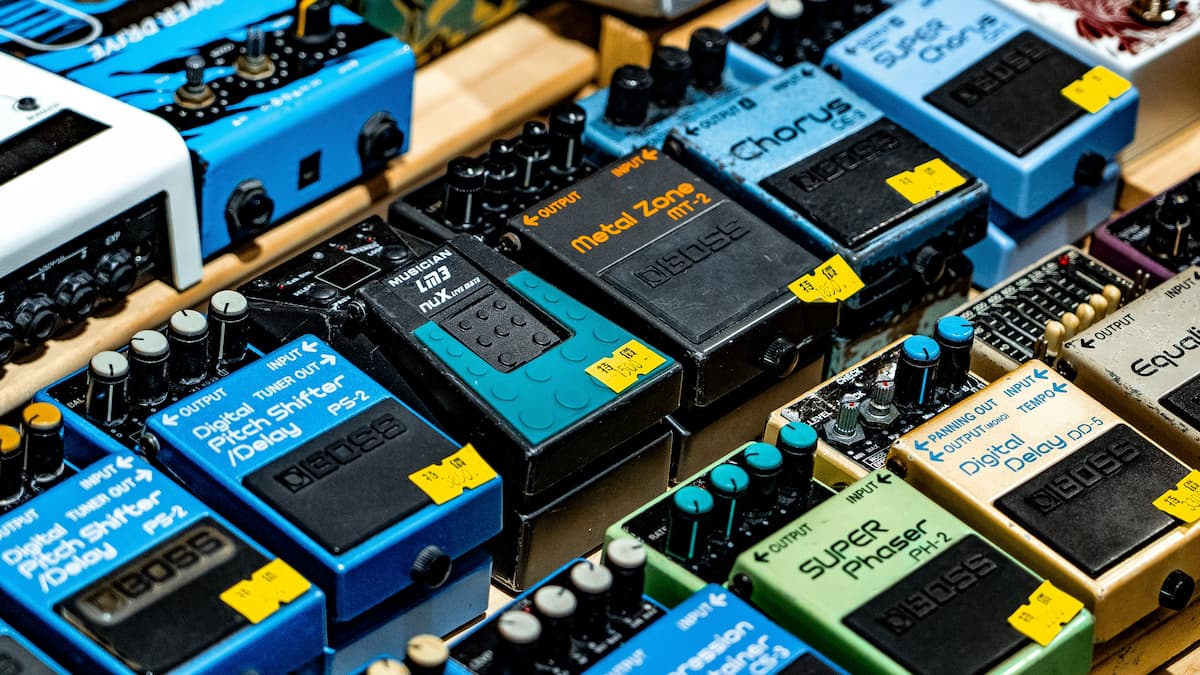BOSS Guitar Pedals: History
BOSS emerged in 1973, reshaping music with Roland Corporation's compact pedal series. This innovation marked the start of professional-grade musical equipment production. From effects pedals to tuners and amplifiers, BOSS caters to diverse needs.
The appeal of BOSS guitar pedals lies in their compact, reliable design. Musicians favor them over cumbersome, traditional setups. As BOSS guitar pedals gained popularity, so did demand for their innovative products.
This journey reflects BOSS's commitment to quality and musician's needs. Today, BOSS guitar pedals history continues to inspire and evolve.
A Historical Journey of BOSS Guitar Pedals
BOSS guitar pedals history began shaping music in 1973. They are marking a revolution in sound and creativity.
Let's explore BOSS's beginnings and its diverse lineup. Starting from their 1973 launch to today's innovations.
Who Is BOSS?
Founded in 1973, BOSS emerged as a titan in the music industry, revered globally. In 1975, the electronic music surge spiked demand for electric guitar and bass pedals. BOSS introduced the compact pedal, revolutionizing the effects of the pedal landscape. These single-function analog pedals were smaller than the usual guitar effects boxes. Their compact size made them essential for live performances.
Musicians favored these pedals for their quality sound at manageable volumes. This innovation set a new standard, making BOSS guitar pedals indispensable on stage. BOSS's journey reflects a commitment to quality, durability, and creativity. Their products have become a staple for musicians seeking reliable sound enhancement.
Through the years, BOSS has maintained its status by innovating. Music enthusiasts celebrate BOSS guitar pedals today for their robust design and sonic precision. They embody a legacy of pushing musical boundaries. BOSS's guitar pedals history is a testament to their impact on music and technology. Their story is not about pedals but about shaping the sound of generations.
What Range of Products Does BOSS Offer?
Before diving deeper, let's outline what BOSS offers. Familiar to many, BOSS crafts more than pedals. Their mission: deliver high-quality instruments at fair prices. Also, echoing the ethos of Fender in the electronic realm. Their portfolio spans several categories, each with its variations.
Below is the list of their product categories which come with various variations:
- Effects Pedals
- Multi-Effects
- Loop Station
- Guitar Synthesizers
- Mixers and Audio Solutions
- Wireless
- Vocal Effects
- Acoustics
- Tuners and Metronomes
- BOSS Amplifiers
- Roland Amplifiers
- Other accessories
Defining Guitar Pedals
Guitar or effects pedals are vital tools for guitarists to shape their sound. They're effects units that enhance a guitar's tone. Not every device qualifies as a guitar effects pedal; certain features are essential.
These devices fall into two categories: multi-effects and individual pedals. Multi-effects pedals are versatile, catering to both novices and pros. They maintain signal integrity, regardless of the number of effects used. With everything at your fingertips, tweaking effects on a multi-effects pedal is straightforward.
Individual pedals, while requiring more effort, offer unique benefits. They allow for a customized effects chain, tailored to the guitarist's needs. Whether for experimentation or specific soundscapes, guitar pedals are indispensable. They grant musicians the creative freedom to explore and define their sonic signature.
Within the realm of BOSS, this exploration reaches new heights. BOSS's guitar pedals history showcases a commitment to quality and innovation. Their range caters to every guitarist's needs, from the studio to the stage.
Understanding guitar pedals is the first step in harnessing their full potential. With BOSS, guitarists push musical boundaries and craft distinctive sounds.
The Collaborative Legacy of Roland Corporation and BOSS
Discover the bond between Roland and BOSS, two giants in music gear since 1973.
Their joint venture has revolutionized guitar pedals, merging innovation with quality. This alliance has deeply influenced music production's landscape.
Who Is Roland Corporation?
Roland Corporation has been a beacon of innovation in the musical world since 1972. Founded by Ikutaro Kakehashi in Osaka, it redefined music production and performance.
With the debut of the HC-2 cassette deck in 1974, Roland set its mark. It became a leader in manufacturing musical instruments and recording devices. The digital age saw Roland introducing groundbreaking keyboards, synthesizers, and digital pianos. They also created rhythm machines that catered to both professionals and hobbyists.
In 1984, Roland's digital multi-effects units for guitarists, through BOSS, broke new ground. The DA-20, featuring the world's first BCD processor, marked a historic moment. As a multinational entity, Roland moved its headquarters to Hamamatsu, Shizuoka, in 2005.
Its global presence thrives with factories in Malaysia, Taiwan, Japan, and the USA. By December 2022, Roland had grown to have employees of 2,783 individuals—a 2014 management buyout led by CEO Junichi Miki, with Taiyo Pacific Partners. Instruments like the Juno-106 synthesizer and TB-303 bass synthesizer became industry staples. The TR-808 and TR-909 drum machines are legendary, shaping genres and eras.
Roland's role in developing MIDI revolutionized electronic music collaboration. Critics and enthusiasts recognize Roland's unparalleled impact on electronic music. Roland and BOSS's journey reflects a relentless pursuit of excellence in music technology.
Relationship Behind Roland and BOSS Corporation
The synergy of Roland and BOSS Corporation highlights their shared musical legacy. Rooted in innovation, Roland's foundation in 1972 set the stage for BOSS's emergence. As a division of Roland, BOSS has thrived, known for pushing musical boundaries. Their collaboration has catered to both beginners and touring professionals alike.
BOSS's iconic pedals like the Chorus and Flanger showcase the partnership's strength. Together, they've tailored their offerings to enhance musicians' global experience. This relationship stems from a profound understanding of artists' needs.
Roland's broad vision and BOSS's specific focus combine to serve the music community. Their collaborative efforts have resulted in groundbreaking products celebrated worldwide.
The Roland and BOSS connection is more than corporate. It's a shared mission to innovate for musicians. This alliance has produced legendary pedals and shaped modern music. Their understanding of each other's strengths has been key to their success. Through collaboration, they enrich every musician's journey.
BOSS Guitar Pedals: History and Timeline
Explore the fascinating history and timeline of BOSS guitar pedals, a legendary brand. Renowned for pioneering compact guitar pedals, BOSS has innovated over the years.
Their timeline extends beyond pedals to include recording products, amplifiers, and more. BOSS's journey is captivating as one of the most trusted names in guitar pedals.
1960s: The Dawn of BOSS
The late 1960s set the stage for future musical innovations. Semiconductor technology was advancing fast. This period was critical for the music scene, especially rock.
Semiconductors were becoming widespread, enhancing musical equipment. These advancements made way for more compact, affordable effects units.
The rise of rock increased the demand for unique sound effects. Musicians sought to explore and innovate. The late '60s technological leap influenced BOSS's creation.
These semiconductor breakthroughs were not about electronics. They also revolutionized musical expression.
The 1960s' technological progress predated BOSS but was essential. It shaped the environment into which BOSS launched its first pedal. This era underscored the importance of innovation in BOSS guitar pedal history.
Early 1970s: BOSS Begins
The early 1970s marked a revolution in guitar sound. Before then, amps or PA systems limited the effects. This era brought standalone effects boxes, changing music forever. These boxes offered reverb, echo, and the iconic wah-wah function.
In 1973, BOSS began its journey, soon becoming a giant in effects pedals. Known for their distortion and overdrive, BOSS's legacy grew with modulation and delay. These effects have become industry classics, shaping sounds across genres.
BOSS guitar pedals were not for electric guitars alone. They also found their way into acoustic and bass lines. The company's impact extended beyond hardware. Chip technology in the seventies enabled BOSS to pioneer digital delay pedals.
This innovation offered guitarists new ways to simulate echo effects. BOSS's early days set a high standard for quality and innovation. Their pedals have become essential for musicians seeking unique soundscapes.
The story of BOSS guitar pedals history is a testament to their enduring influence. From their 1973 start, BOSS has been at the forefront of sound innovation.
Late 1970s: BOSS's Debut and Early Classics
The journey of BOSS guitar pedals began in 1977, marking a revolution in guitar sound. Their debut with the OD-1 Overdrive set the stage for a new era in music. This pedal, known for its rich, warm tones, became a cornerstone for guitarists.
By 1977, BOSS had already made its mark with the OD-1, a symbol of innovation. The company didn't stop there. Classics like the Phase Shifter PH-3 and the CM-2 Compressor followed. These pedals have stood the test of time and are still cherished by musicians today.
In 1979, BOSS introduced the CE-2 Chorus Ensemble Pedal, further cementing BOSS's status. Although primitive by today's standards, the CE-2 was groundbreaking. It played a pivotal role in shaping the sound of the late 70s and beyond.
The late 1970s were transformative years for guitar music, thanks to BOSS. Their pedals, especially the OD-1 and CE-2, are legendary. They not only altered the sound of guitars but also transformed how players used them.
BOSS's early innovations laid the groundwork for decades of musical creativity. Today, these "Big" pedals are not tools but icons of a revolutionary period. The BOSS guitar pedals' history is a testament to their lasting impact on music.
1980 - 2000: The Innovation Continues
The '80s and '90s were pivotal for BOSS, marking innovation in guitar effects. Starting with the CS-1, BOSS introduced groundbreaking pedals like the PH-1 Phaser. The era saw classics like the Super OverDrive SD-1 and Delay DM-2 emerge. Each new pedal, from the GE-1 Equalizer to the OC-2 Octave, added unique dimensions to the music.
The CE-3 Chorus and HM-2 Heavy Metal showcased BOSS's range. By the mid-'80s, BOSS was a top guitar pedal maker, highlighted by the Digital Delay DD-2. The late '80s brought the Turbo Distortion DS-2 and Digital Reverb RV-2, among others.
The '90s introduced pedals like the Digital Space-D DC-3 and Super Chorus SH-1. These years catered to evolving genres and player needs with pedals like the Metal Zone MT-2. The late '90s saw popular pedals like the Blues Driver BD-2 and Bass Synthesizer SYB-3. The Chromatic Tuner TU-2 became a pedalboard staple.
BOSS's guitar pedal's history showcases its impact on music through quality and innovation. This period underlines BOSS's commitment to meeting musicians' evolving needs.
2001-2013: Advancing Innovation
From 2001 to 2013, BOSS set new standards with innovative guitar pedals. This era introduced essentials for guitarists, known for their ease and sound quality. The Phase Shifter PH-3 and Dynamic Wah AW-3 added new modulation effects. The Flanger BF-3 and Digital Reverb RV-5 offered unique textures. The Super Octave OC-3 deepened octave effects, while the AC-3 simulated acoustic tones.
The RC-2 Loop Station revolutionized looping for creativity. The Metal Core ML-2 delivered heavy tones for metal enthusiasts. The Fuzz FZ-5 brought vintage fuzz effects back to life. The DD-7 Digital Delay expanded delay possibilities with advanced features. The TU-3 Chromatic Tuner became the preferred tuner for its accuracy.
The Power Stack ST-2 mimicked the sound of a full stack. The Tera Echo TE-2 introduced unheard echo effects, showcasing BOSS's innovation. Each pedal from this period inspired musicians with practicality and new sounds.
Between 2001 and 2013, BOSS reinforced its reputation with guitarists globally. These years they have highlighted BOSS's commitment to quality, innovation, and meeting musicians' needs.
2014: A Record Year
2014 was a standout year for BOSS and guitar pedal enthusiasts. It marked a record year for the company, with new releases captivating fans. Among these, the Waza Craft series stood out, celebrating 20 years of pedal innovation. This series brought modern twists to BOSS classics, rejuvenating guitar sounds.
The Waza Craft pedals blend vintage vibes with cutting-edge updates. The designs aimed to offer more than what's on the surface. These pedals became favorites, known for their exceptional quality and unique sounds.
BOSS didn't stop with the Waza Craft series in 2014. They also introduced the X series, expanding their lineup further. This move showcased BOSS's ongoing commitment to innovation and quality. Each release in 2014 underscored BOSS's dominance in the guitar pedal market.
The year 2014 reinforced BOSS's reputation for combining classic tones with modern technology. The Waza Craft and X series pedals have since become must-haves for guitarists. This period in BOSS guitar pedals history highlights a pivotal moment of excellence.
2017: The Digital Age
In 2017, BOSS continued its legacy as a pioneer in the guitar pedal industry. Celebrating over 45 years of innovation, they launched the 500 series pedals. This new line revolutionized effects with digital presets and programmable memory.
The 500 series brought Overdrive and Distortion into the digital age. These pedals allow for unprecedented customization and precision. With these advancements, BOSS set a new standard for versatility and control.
The introduction of programmable settings was a game-changer. Guitarists could now save and recall their favorite tones. This level of customization was unheard of in previous models.
BOSS's innovation didn't stop at sound quality. The 500 series pedals also featured an easy-to-use interface. This made them accessible to both beginners and seasoned professionals.
The release of the 500 series in 2017 underscored BOSS's commitment to quality. It also highlighted their dedication to meeting the evolving needs of musicians. This launch further cemented BOSS's position as an industry leader.
2019: Compact Power
In 2019, BOSS took a bold step by ending the 20 series pedals. This move led to the launch of the compact 200 series. Despite their size, these pedals promised superior sound quality. They featured an innovative acoustic chamber for enhanced audio.
This change shows BOSS's commitment to innovation and meeting musicians' needs. The 200 series offers more functionality and versatility for modern players. It marked a significant evolution from the 20 series, showcasing BOSS's adaptability.
The introduction of the 200 series in 2019 reinforced BOSS's market leadership. It continued its tradition of excellence and sound innovation. This development highlights BOSS's ongoing dedication to quality and musician support.
BOSS Guitar Pedals History: Where Does BOSS Produce Their Effects Pedals?
BOSS guitar pedals have set the industry standard for decades. Musicians globally embrace these iconic effects. But where are they made?
BOSS manufactures in Japan, Taiwan, and Malaysia, all in the Pacific Rim. Despite some production outside Japan, Malaysia now leads in making most BOSS guitar pedals.
Each pedal undergoes strict testing and quality checks by dedicated employees. This ensures every unit is ready for musicians worldwide.
This global production ensures BOSS guitar pedals maintain their legendary status. Every step, from creation to testing, upholds BOSS's commitment to quality.
Adding to their rich history, musicians globally embrace these iconic effects. It highlights the brand's dedication to crafting the best effects for guitarists.
BOSS Guitar Pedals History: Conclusion
BOSS guitar pedals have shaped music for over four decades. From their humble beginnings to global manufacturing in the Pacific Rim. They've set the standard for quality and innovation. Each pedal, crafted in Japan, Taiwan, and Malaysia, reflects a commitment to excellence.
BOSS's rigorous testing ensures that musicians worldwide receive only the best. This dedication has cemented BOSS as a leader in the guitar pedal industry. The BOSS guitar pedals history is a testament to their enduring impact on music.
As they continue to innovate, their legacy will grow. BOSS pedals are not effects; they are tools for artists to express their unique sounds.





